350 yards from my house there is a trailhead that descends into one of my favorite places in the world. Eaton Canyon lies at the foot of the San Gabriel mountains, located on a northeast edge of Los Angeles, and it is not just my local canyon and my favorite birding patch, it is also my childhood canyon. It is a place full of memories and magic. Since March of 2020, however, I have been unable to enjoy the simple pleasure of grabbing my binoculars and walking out the door to head down to check on the chaparral birds there, despite my being thoroughly grounded here due to the pandemic. The canyon is so close, but remains mostly closed today, accessible only through a limited and complex reservation system. One is now required to drive to its farther entrance, go through security, and stay only three hours.
350 yards is only slightly less than the territorial range of one of North America’s most unique birds, the Wrentit. The only representative in the New World of an Old World radiation, the Wrentit is currently believed to be most closely related to the parrotbills of Asia, though old world warblers and Asiatic babblers have previously been considered. Nothing is close to it here though. It is a strange little bird. With a lifelong home territory of about .62 hectares (that’s about 1.5 acres), and juveniles leaving home to settle a whopping 400m on average from their natal grounds, they were once described as the most sedentary bird species in North America. I can relate.
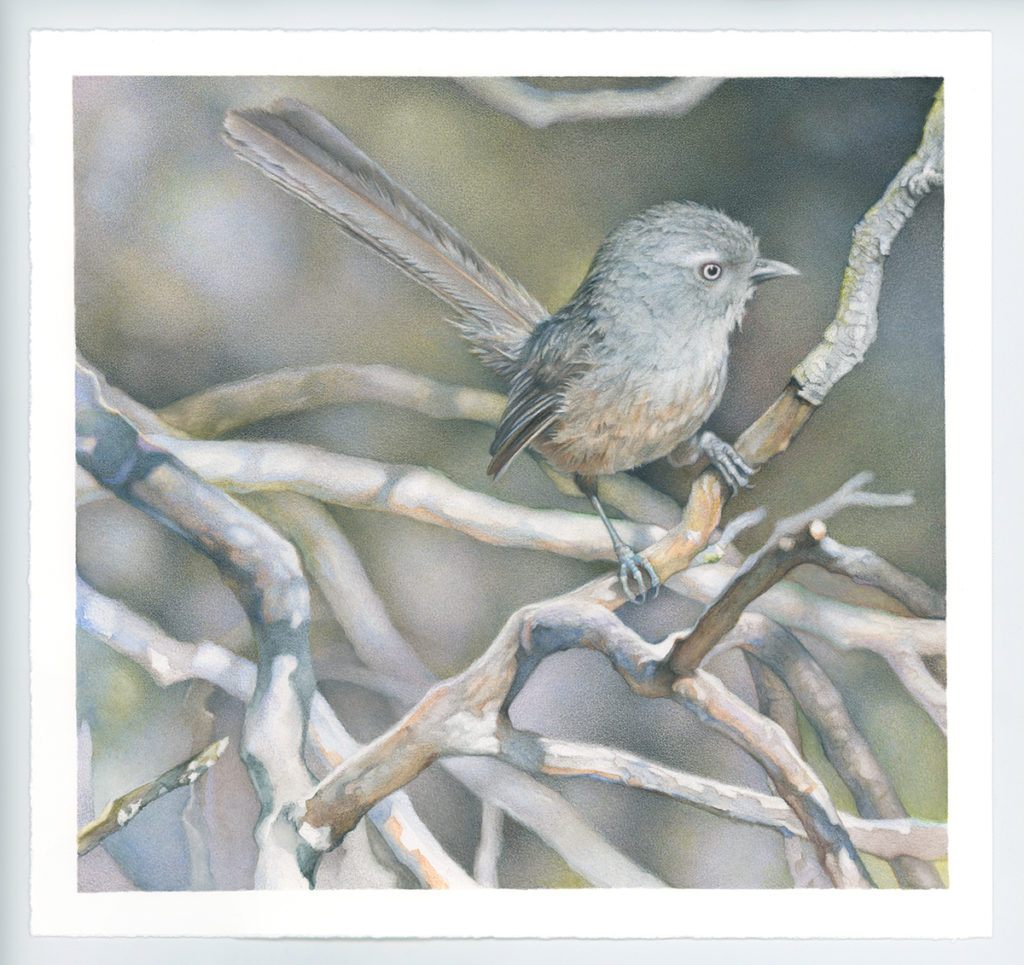
Though my house is within territorial striking distance, and though my property hosts some pretty nifty chaparral bird species, I will never see a Wrentit in my yard. They need what is in the canyon, not what grows in established pseudo-feral suburban gardens, even ones like ours where we are working to establish native plants. One of their favorite tangles to reside in, and whose fleshy drupes sustain them through winter when there are fewer fruits, insects, and spiders to glean, is poison oak. Maybe someday. This year, I can hear them as I walk my dog near the canyon in the afternoons, but I never see them. Their simple bouncing ball of a song has many practical uses in their lives, and has very few variations, but it is certainly loud. Both sexes sing. It is the first bird song I learned as a child.
Last week I scored a reservation to hike in the canyon. It’s not quite time yet for Wrentits to breed, but they sing year long, stay monogamous (even roosting together in little family fluff mounds), and can be in the same general territory for up to 12 years. I’m sure the average is much lower than that, but still. It has only been a little over a year since I last saw them there. I headed straight to where I had last seen them, at the edge of the wash, and was startled by a loud song almost immediately. There really aren’t the hordes of people in the canyon any more to inure them to us, and I had provoked one into giving a territorial proclamation. As I slowly turned around I saw two of them looking at me from the edge of a large toyon, with their characteristic fierce gaze (they have disconcertingly white irises, ringed with a blood maroon outer iris). The same presumed pair I had seen over a year ago, they were no longer concerned with me, and dropped into a very mature poison oak patch, skulking and gobbling up seeds as they went along, exactly as they are supposed to.
References:
Allen, Larry W., Kimball L. Garrett, and Mark C. Wimer. 2016. Los Angeles County Breeding Bird Atlas. Los Angeles Audubon Society, Los Angeles, CA.
Johnson, N.K. (1972c). Origin and differentiation of the avifauna of the Channel Islands, CA. Condor 74: 295-315
Erickson, M.M. (1938). Territory, annual cycle, and numbers in a population of wren-tits (Chamaea fasciata). University of California publ. Zool. 42:247-334.
Geupel, G.R. and G. Ballard (2020). Wrentit (Chamaea fasciata), Version 1.0 in Birds of the World (P.G. Rodewald, Editor). Cornell Lab of Ornithology, Ithaca, NY, USA.
https://doi.org/10.2173/bow.wrenti.01
The art of enjoying birds without filter
The Spanish ornithologist José Luis Copete is known among insiders for his research on the Desert Owl and the description of Strix hadorami five years ago. Nowadays, birdwatchers of the Spanish-speaking countries appreciate mainly his podcasts on scientific discoveries in the world of birds. In our interview he talks about the regional dialects of birds, what distinguishes Finnish birdwatchers from Spanish ones and about his special bird observations in Barcelona at the time of the lockdown. Although he has been working as photographic editor for many years, he recommends the pure joy of birdwatching without an object lens. In addition, he reveals his favorite birding spots in Spain.
Tell us about yourself and the Team Reservoir Birds.
It all began when Stefan Riedl, who runs Excopesa, the distributor of Zeiss in Spain, asked some years ago to Francesc Kirchner for a birder in Spain with a good profile to be the face of Zeiss in the birding scene here. Francesc contacted me, and then I suggested to include in the team Ferran López and Dani López-Velasco. Ferran has been working monitoring birds in the Llobregat Delta reserves for more than 20 years and is the Spanish birder with the top list of WP species. Dani is very well known internationally because his role as a guide for Birdquest, traveling worldwide. We all three are respected birders in Spain -and we suppose that’s also the case away- and most important, very well known inside the Spanish community, because we have met with most of the birders in every corner. The name of the team comes from the website of birding news we manage, Reservoir Birds.
When did you start with birdwatching and what was the trigger/reason for it?
I began in the world of birds in 1981, when I was 12 years old. Actually my first interest were the herpetos, lizards and snakes. When I was a kid I spent countless hours moving stones to catch herpetos. My first guide was the classic book by Arnold & Ovenden about herpetos of Europe. However one day a contact from my mother made me to visit a ‘masia’ (the catalan name for farmhouse) in Tiana, a town not far from Badalona, near Barcelona, in the Serra de Marina, where he was going to ring birds. This sounded to me like sci-fi. I didn’t have an idea of what was the activity. That guy also had 12 years old, he went there with more older guys who were training younger people. On the very first day, going to the nets to release the birds trapped, and watching them in the hand, putting the rings, reading the Peterson bird guide, I was caught by this. I convinced my parents to buy my first bird guide on that year, and spent as many hours as possible in Tiana. So, I actually began as a ringer, not as a birder. The fact is on my very first years I didn’t understand some statements by birders coming to Tiana ringing station, like the difficulty to watch Garden Warbler on migration, when I knew it was so easy to ring the species in September putting a net next to a ficus. It was during 1983 when I discovered more properly what meant to be a birder, beginning to spend time only watching birds. To be honest, I’ve to admit that the first reason was to learn about birds in the hand, and secondly their songs/calls. From the beginning I was very interested to identify their voices, it was the reason to watch the birds in the forest in Tiana, to confirm the song/call belonged to the species I was supposing. The commonest were easy to tell apart. However when the migrants in spring and autumn I heard more voices, and watching the birds to confirm every sound was the main reason of my interest in watching them. At that time there was no internet, no xeno-canto, you needed to learn the sounds in the field. It was in my opinion a very good way to get interested in birds. Later on, when I had more birding friends, I combined both activities, and began to be more interested to watch birds as a pleasure.
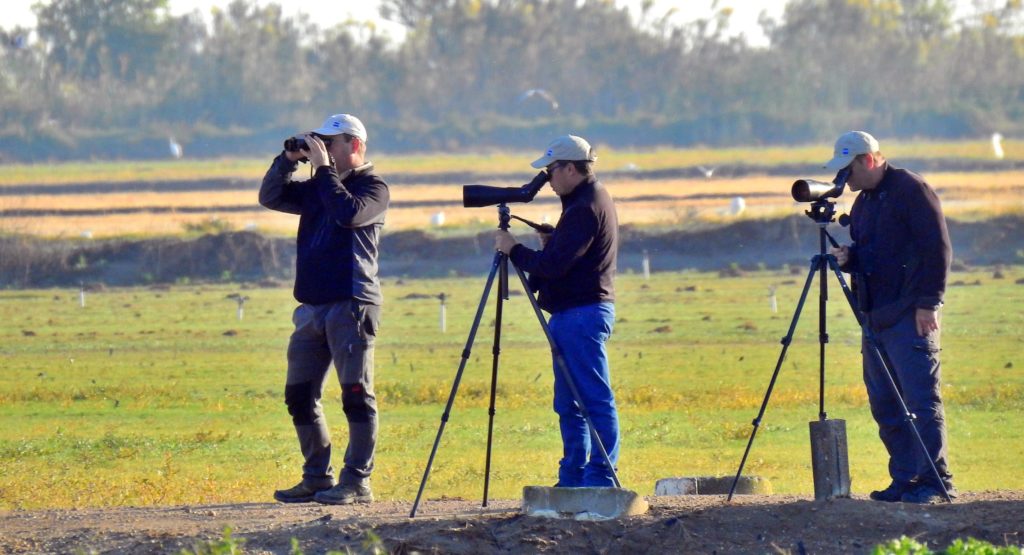
What were your personal experiences of birdwatching during the Covid19 pandemic?
It was quite difficult, since my flat in Barcelona city is not offering special chances. I maintained a list of the species detected from my balcony when the strict confinement in March/April, arriving only to 38. However I’ve to say I saw some interesting species like Peregrine Falcon or Blue Rock Thrush, and by night I heard from my bed flamingos and Greylag Geese calling overflying the city. The absence of cars and noise by night helped to detect these flocks calling in the middle of the night. Apart of these experience during the strict confinement, the pandemic stopped all my plans of travels during 2020. In August it was supposed I’d to be in Colombia, however that trip was cancelled. So, when we had the opportunity to scape between the different levels of confinement we had in Spain, I focused more on local birding, like in Collserola hills surrounding Barcelona.
You tested the new ZEISS SF32 binoculars during the Global Bird Weekend. What were your favorite features of the product and what makes it special for you?
Two of the main features of the new ZEISS SF 32 impressed me: they are so light, that you can hold them wiht one hand without much effort; and the sharpness and luminosity. I knew before to test them they were x32, however I was really impressed by the level of light despite 1 cm less wide that the normal x42 I’ve been used to carry in the field. They are so light and sharp, that I don’t plan anymore to change my bins!! They are truly spectacular. They are simply stunning, the best binoculars I ever tested.
You are also interested in nature photography. Can you please tell us a bit more where your focus is and what would be the tips you would give to beginners of nature photography?
Well, I’ve to say that I would recommend to beginners rather than taking pictures all the time (something which is not bad in the end), to concentrate, when they begin, to watch birds. Nowadays there is a fashion to watch birds through cameras, especially since the mirrorless models are accessible because reasonable prices and not so heavy weight, to a lot of people. However I saw in the excursions and trips we guide for our company Icaro Birding Experience, that a lot of younger guys are only taking pictures with these models, to try to watch the image displayed on the screen. Most of the time they are not watching the bird but trying to get a picture to zoom in on the screen. That’s not the best way to learn about birds. My recommendation would be to watch birds with good bins, trying to focus on their behaviours, their movements, how they take food, etc…as well to try to learn all the voices they can listen. Later on, when you have more experience, getting inside the photography.
What is your most exciting motif of mammal photography (which mammal)?
That’s easy to answer. My most desired mammal to be seen in the wild was Snow Leopard. Because it’s so difficult to be found, as well as because it lives in remote areas, normally on rugged terrain, which is adding a component of mystic to their figure. So, when I saw it for first time in Ladakh in 2015, together with one of our team members at that moment, Dani, it was one of my best moments in the field.
I worked as photography editor for the Handbook of the Mammals of the World on the entire series, where I had to check more than 350.000 pictures of mammals. So, after 10 years of checking and selecting pictures of mammals (not to mention how many I had to do for the same role on the HBW dealing with bird pictures), I can say I got some experience to know which mammals has been well photographed and which others are not. Snow leopard images improved a lot during the last five years, after some photographic trips for the species began to be operated. Fortunately, we did our trip away of the crowd, in a place where no people was present and where we stayed alone for ten days, without other photographers or tourists. It was a very nice experience, spending days on the mountains trying to discover the Snow Leopard on the ridges by ourselves.

Which would be THE recommended birding destination in Spain and which birds are expected to see there?
It’s difficult to mention only a place. I would mention some very different places which are on top of what I would recommend to foreigners coming to Spain. One is the steppic area near Belchite, in spring, when you can watch flocks of sandgrouses, listening Dupont’s, Calandra, Lesser Short-toed and Short-toed Larks as a dawn chorus, Stone Curlews, and watching some raptors like Black Kite, Golden Eagle and others, apart of the many migrants like warblers, wheatears, chats, and many others. Another place to recommend is Estaca de Bares in autumn, combined with some seawatching by boat. Spending a few days there in September/October offers the most impressive seawatching migration in Europe, with thousands of shearwaters, terns, alcids, skuas, and manhy other seabirds, sometimes quite close from the cap, from a panoramic view over the sea which is unparalleled. Finally, because is one of the places where I stay more regularly, I would also recommend the Ebro delta, for a few days in April/May. Waders, ducks, gulls, terns, passerines breeding on reedbeds and wetlands, seabirds, and on migration waves, birds everywhere, and the rarities always possible at every moment.
You have been travelling a lot in the past years. Did you recognize any “regional” dialects of birds and do you recognize your local birds by their sounds?
Many times is difficult to know when is the boundary between individual variation and dialect. However in some species this is not especially difficult, as happens with the Ortolan Bunting. I spent several years working on a research project on the species, in La Segarra county, Catalonia, from 2013 to 2018. The local dialect of the species there is different from that you can listen in central and north Europe. Not only that: when you try to use playback with recordings of central Europe to our local birds, their reaction is not really straight. Very different when you use playback of the song you recorded of the birds breeding in the area: the reaction is straight, very aggressive. They of course identify those playbacks as true competitors. Not the same when they listen Ortolan Bunting song from Germany!
Have you recognized any differences between the ornithologists in other countries?
What I saw is more related to social and cultural differences. People in Spain is quite heterogenous, as corresponds with a society with different languages, ways of life, different cultures and traditions. However, I noticed that birders in Finland, which I consider they are one of the best birders in the world as a community, they are quite similar in the way they go to the field, carrying many of them the finstick, rubber boots, similar dressing, etc… and they have a good school of birding, is normal there to meet people you doesn’t know the name who are very good in the field. That’s is quite different in Spain, where there are quite a lot of different birding levels, different dressings, since is not the same being in the field in Galicia, the northwest corner where rains a lot, that being in the field in Andalucia, quite hot and a more Mediterranean landscape. We are also more noisy people, Spanish birders talk a lot when they are relaxed. Away of Spain I found people to be more silent. That’s something easy to detect.
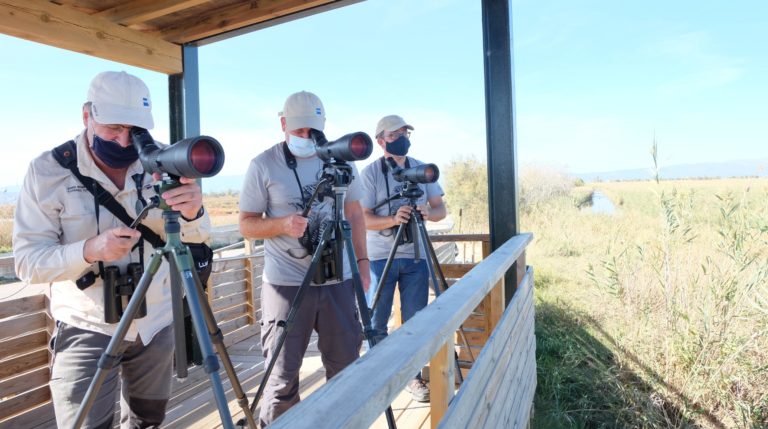
When you think of nature conservation, which species do you personally have in mind to put a focus on?
Rather than a species, I think more on a community of species related to a specific environment: the birds breeding in agricultural fields. A lot of species depend on this, and many of them suffered heavy declines. Species like Ortolan Bunting, the flag of the recent European breeding bird atlas, is a good example, since it suffered a big contraction of the range. It’s because the intensification of the agriculture, which is removing the scrubs between fields, the small plants on the boundaries, the fallow fields… I began ot have an age to remember when some species were very common in cultivated fields, but nowadays you feel they are not anymore like in former times, as happens with the Quail. It also apply to the steppic species breeding in open cereal fields, like Calandra Lark, Little Bustard, Stone Curlew, Pin-tailed and Black-bellied Sandgrouses in fallow fields. Is very urgent to reverse this trend.
Tell us more about the podcasts and what is your personal motivation to invest time in this project?
We began La Radio del Somormujo (https://laradiodelsomormujo.com/) in 2018. There were no other podcasts about birds, directed to ornithologists and nature lovers, in Spain. So, there was space to try that project. We discovered it was very well received. And the community of somormujers grew up quickly!! I feel it’s very important to spread the scientific discoveries to the people interested on birds as amateurs. Many of them are not aware of what’s discovered. Divulgation of scientific research, and conservation projects, is one of the most rewarding works you can done since you are helping to promote a culture for conservation of birds. We are arriving to people already being birders, as well as to people just interested in nature, however also to people who is not yet interested as we are. Our aim is to talk about birds in a kind way, explaining anecdotes, introducing some times some humour, to get the people connected. When you talk about science in a very academic way, many people are not interested because you appear distant. You need to get in touch. And the way is to make the communication close to the audience, not trying to sound too much scholastic. We are very proud our message is arriving to more people. Our podcast was chosen this spring as one of the more interesting science podcasts more at the main podcast platform in Spain, iVoox, so an initiative purely altruistic is every time arriving more far away. Thanks to our podcast I participated a few times on some important radio programs in Spain, like A vivir que son días, where I could spread the message about birds. And we have been doing the program by free, every week, getting close to podcast number 100. In January we will arrive to that landmark! The number of people following our podcasts is remarkable, we get over 40.000 downloads. We just expect we can set the structure when we find some sponsor who can help, since it demands quite a lot of time to prepare the program every week, non-stop.
Who wants to listen to the lively and well explained podcasts, chooses one of the programs on https://laradiodelsomormujo.com. It is worth to learn some Spanish for this. Also, with basic Spanish knowledge it is possible to follow. More information about the ZEISS SF32, which José Luis tested, you find here: www.zeiss.com/morediscoveries
The Corn Bunting – The Secretive Neighbor Next Door
Successfully protecting birds in rural areas
The Rhine Plain, near the German city of Mannheim, end of May, 8:30 a.m. For more than two hours, Julia Staggenborg has been painstakingly following an inconspicuous corn bunting with her ZEISS binoculars. She didn’t dare look away, even for a second, since a brief moment of inattention could undo an entire morning’s worth of hard work. Julia was tracking a female corn bunting. She had spotted the bird, bearing a load of dry grass in her beak, just after setting out that morning. This particular specimen was obviously busy building a nest, and Julia wanted to identify its location.
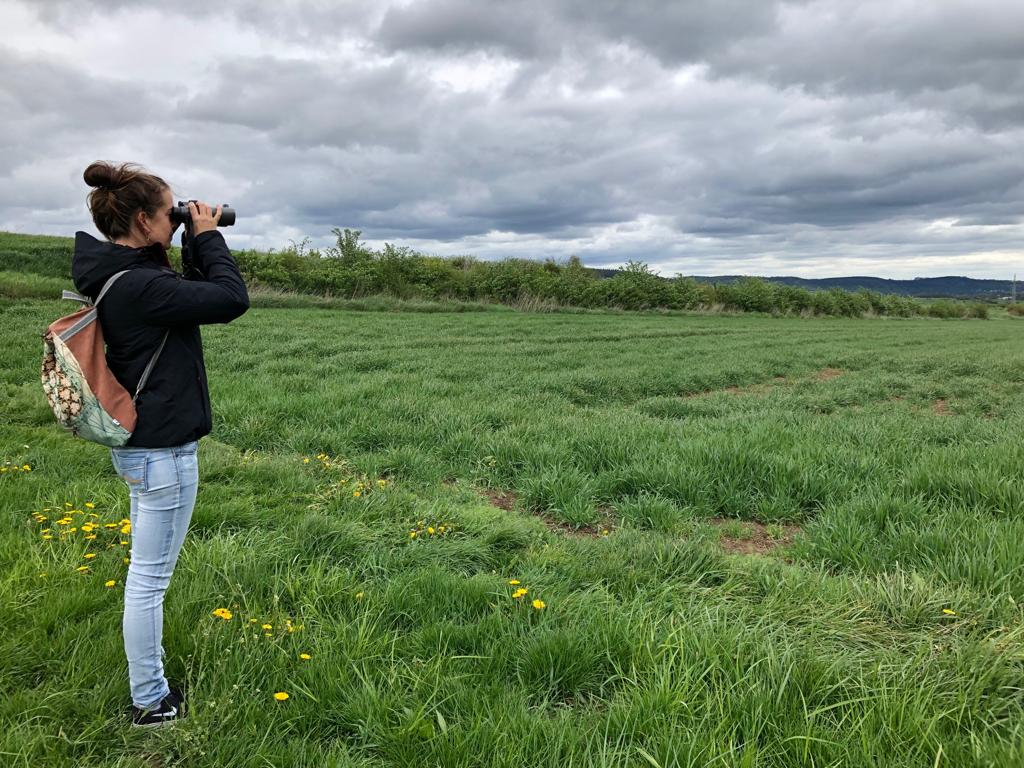
Julia has been working at the University of Tübingen on a project to protect the corn bunting since 2017. The seemingly unremarkable species of bird is considered a characteristic species for extensive, wide-open agrarian landscapes. Particularly in areas like these, it’s especially difficult to effectively combat large-scale biodiversity loss.
The verdict is still out on which environmental protection measures ensure suitable habitats. Frequently, very specific requirements must be met if the land is to sustain a particular plant or animal species. In many cases, little detailed information is available. ZEISS has been supporting the species conservation project since 2016.
Based in the different regions and funded by the Stiftung Naturschutzfonds Baden-Württemberg, a foundation devoted to the protection of wildlife in the area, the project has been able to come up with appropriate conservation measures on the basis of the Corn Bunting’s activities. Working together with farmers as well as environmental protection and agriculture agencies, suitable funding measures have been developed and are being refined in an ongoing process in line with the corn bunting’s needs.
The project team members have been paying particular attention to successful breeding. The corn bunting breeds late in the year, which is especially problematic in agricultural regions because the fledging period frequently conflicts with farming activities. Precisely for this reason, Julia wanted to find out for sure if the bird’s nest in the Rhine Plain was actually located in the farmer’s field. The first hay harvest of the season was scheduled to start the following week, which would invariably destroy the nest.
Or was the nest actually located within the winter barley growing on the adjacent field? If so, then there was no immediate risk because the young corn buntings would have long since left the nest before the start of the harvest.
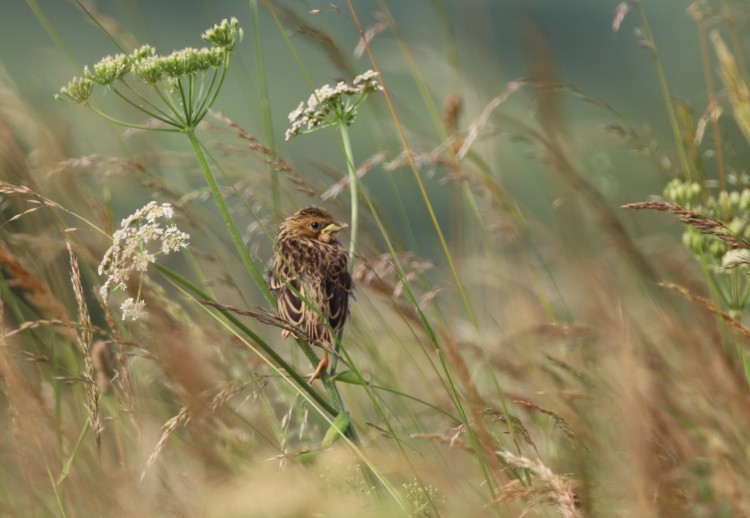
The corn bunting is a true homebody during the breeding period. If the bird notices a passerby or a bird watcher, it lets out a warning cry and ceases any activities in the nest, even if the person is still a considerable distance away. This makes it difficult to spot them, their nests and, consequently, to implement targeted measures to protect them. Thanks to good cover and a high-performance optic, Julia’s conversation efforts paid off.
Potential conflicts between the bird’s particular nesting sites and agricultural needs are just one of the issues being studied. The project members are also focusing on the question of if and where the corn bunting can find sufficient food to feed its chicks, i.e. insects and their larvae. So Julia observes the female birds as they fly in search of food, carefully documenting where they find small butterfly caterpillars or large green grasshoppers to take back to their nests. To be sure, plenty of foliage and fallow ground are quite important, but even areas like conventional farm fields covered with winter wheat offer a surprisingly large food supply for the corn bunting.
The project’s initial findings also reveal substantial regional differences, a clear sign that no single measure will guarantee a happy outcome for the corn bunting or other endangered species living in rural areas dominated by agriculture.
At 8:53, the female corn bunting returned again with more material for her nest. It was evident that she was building it under a prominent knapweed plant in the hay field. The same afternoon, Julia contacted the farmer, who agreed to postpone the harvest in that part of the field by three weeks in return for compensation from the environmental protection authorities. The mother corn bunting and her brood were saved.

